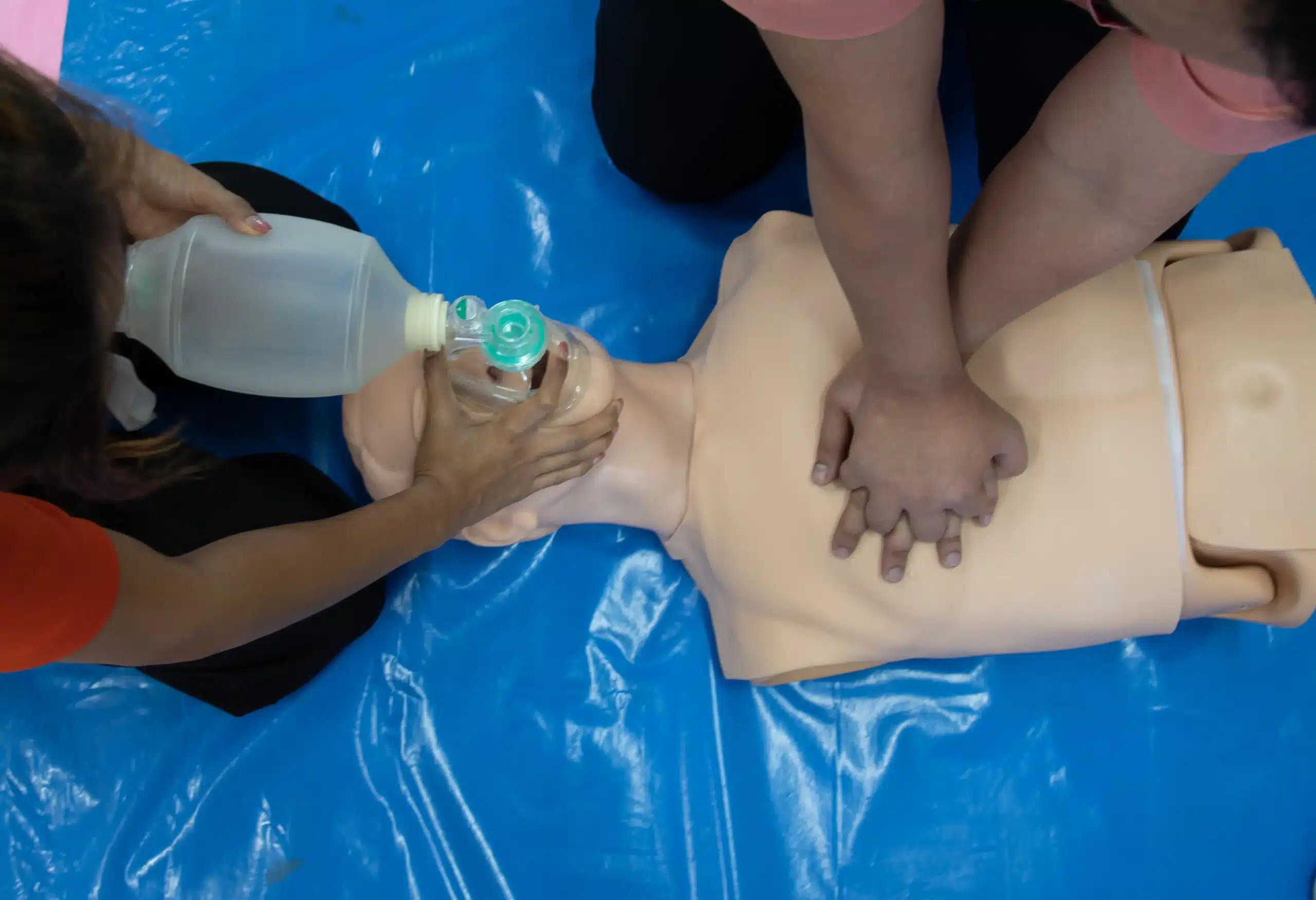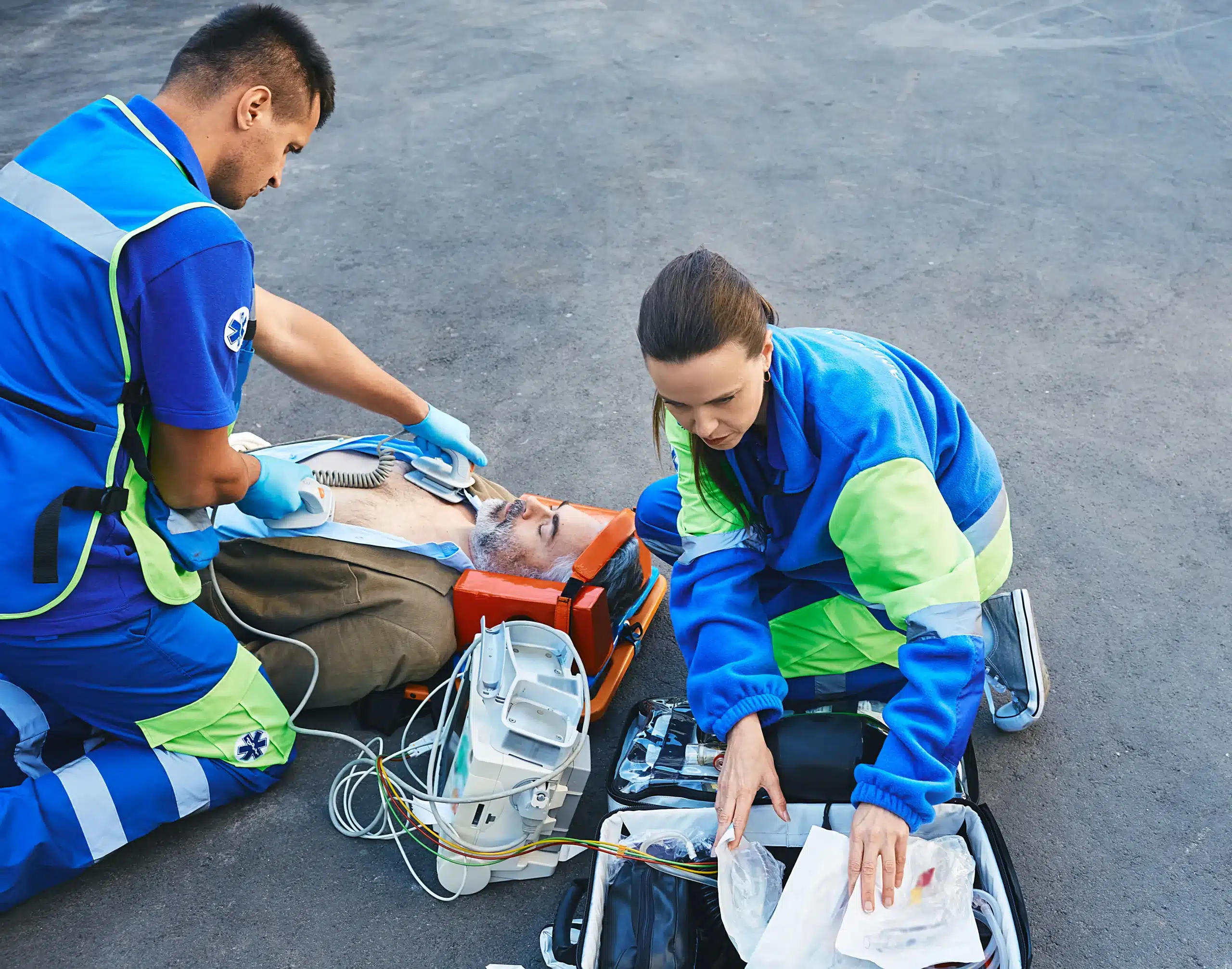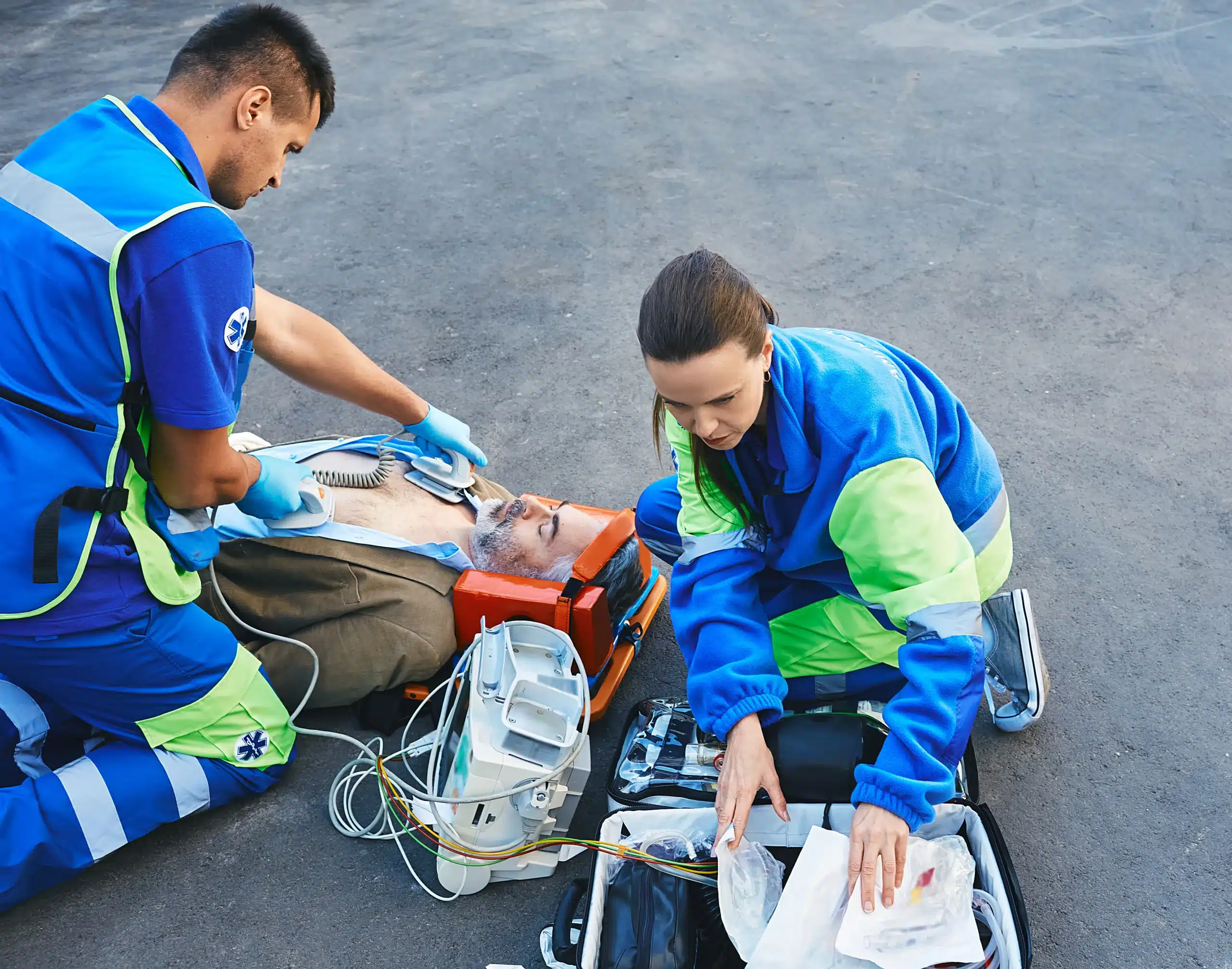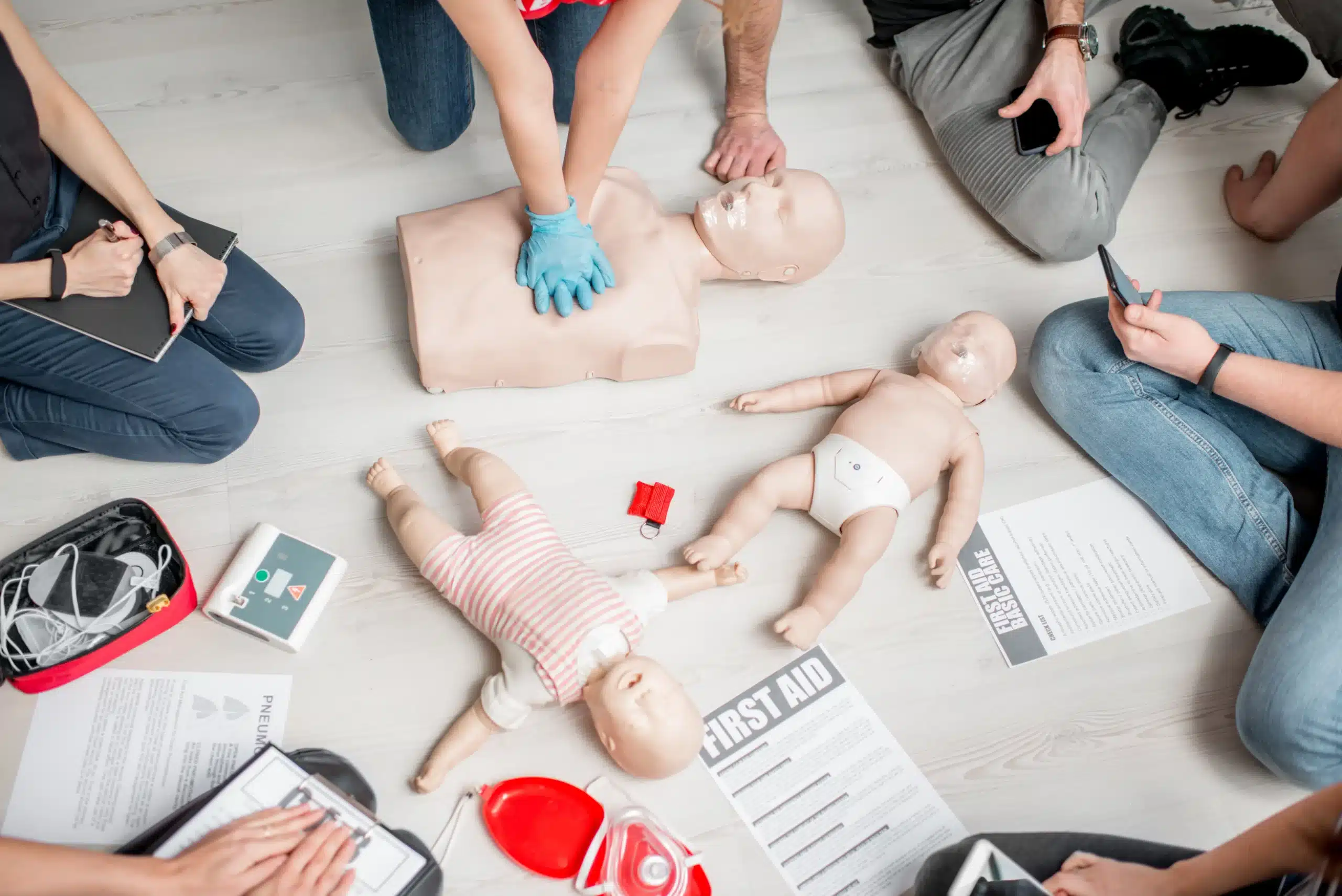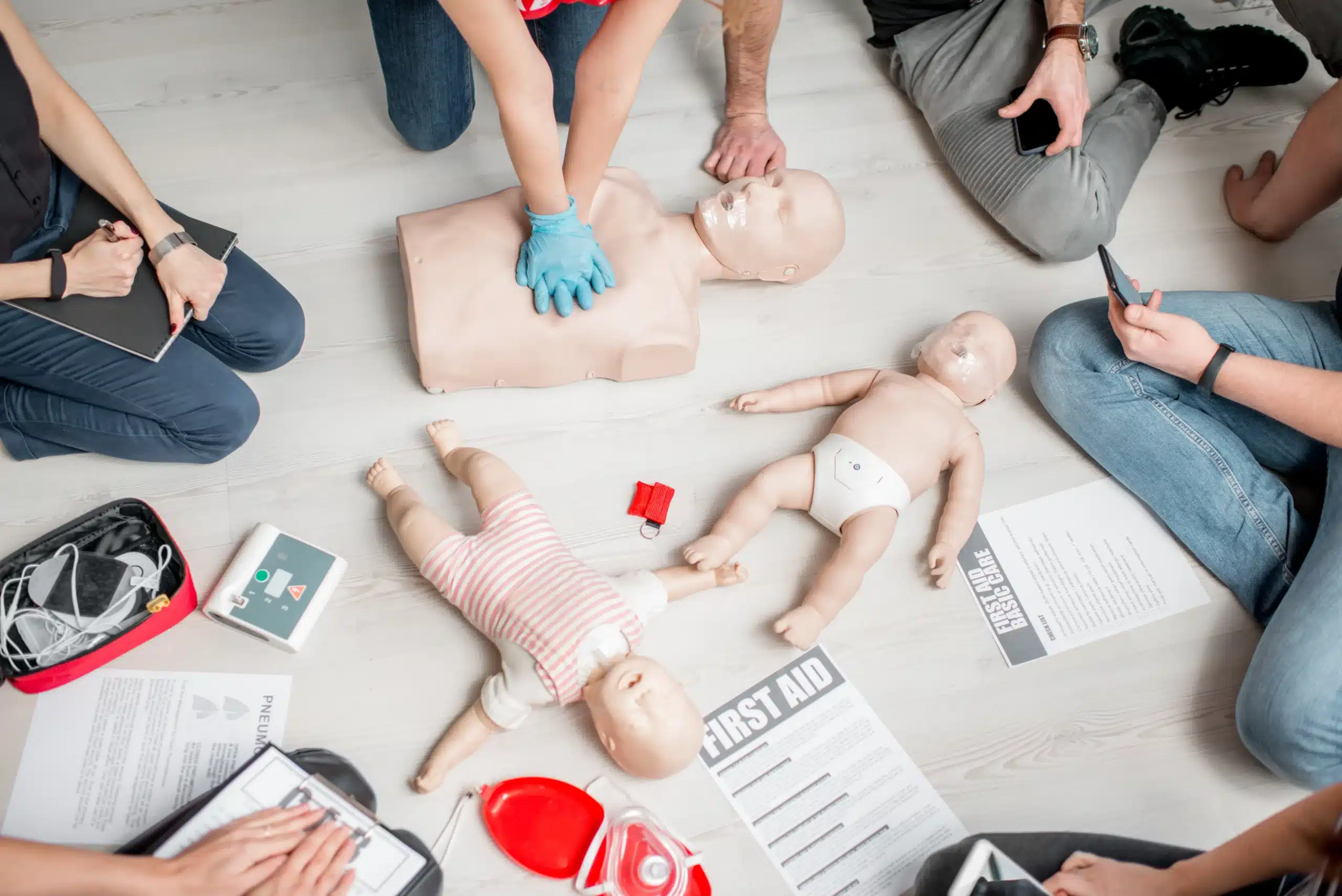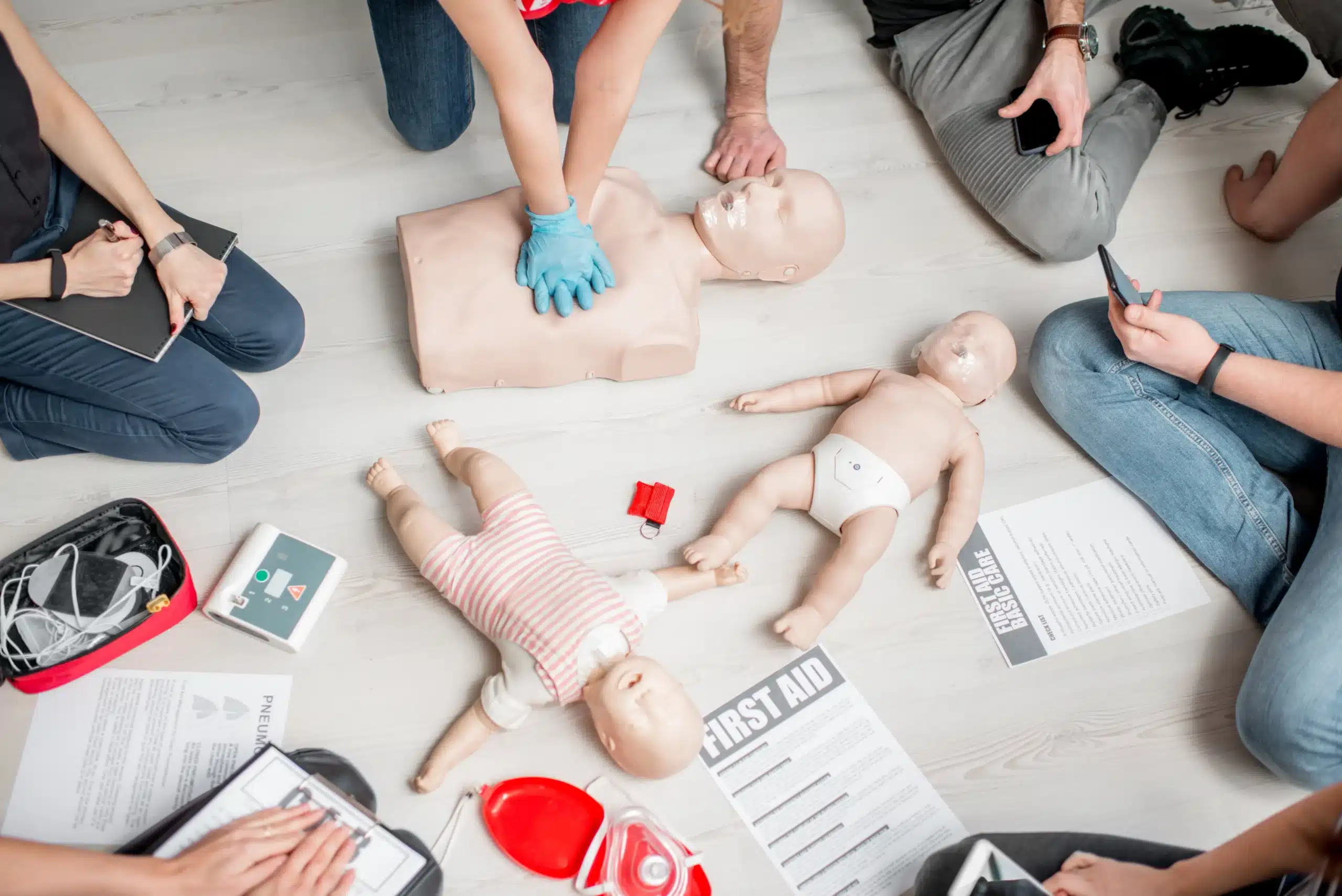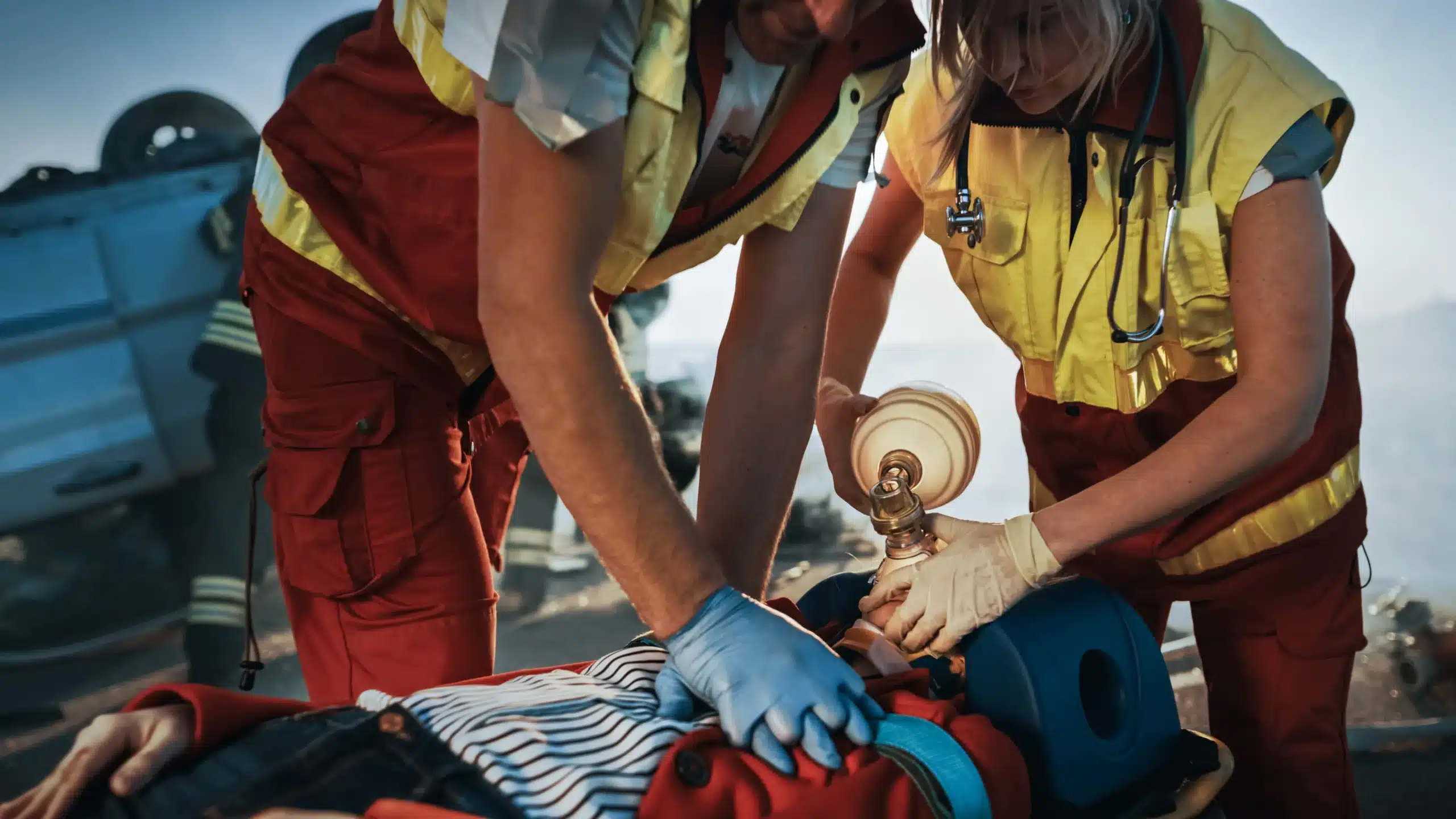Emergencies can be unpredictable. But your response doesn’t have to be. BLS training equips you with the skills to provide immediate care during life-threatening situations, from cardiac arrest to choking. This guide explores the world of BLS, from its core components to the benefits of certification. We’ll discuss different learning options, helping you find basic life support nearby that suits your needs. We’ll also cover what to expect in a BLS course, how to maintain your skills, and the long-term value of this training. Whether you’re a healthcare professional, a caregiver, or simply someone who wants to make a difference, this guide will provide you with the knowledge and resources to get BLS certified.
Key Takeaways
- BLS certification empowers you to save lives: From healthcare settings to everyday situations, BLS skills enable you to respond confidently during emergencies. It’s a valuable asset for both career advancement and personal preparedness.
- Finding the right BLS course is crucial: Consider accreditation, instructor experience, and course format (in-person, online, or hybrid) to choose a program that meets your needs and learning style. Check reviews and recommendations to ensure quality training.
- Maintain your skills for long-term effectiveness: Regularly practice your BLS skills and stay updated on the latest guidelines. Renew your certification promptly to ensure your skills remain sharp and you’re always ready to assist in a crisis.
What is BLS?
Basic Life Support (BLS) is a critical level of medical care used in life-threatening emergencies. Think of it as the first line of defense before more advanced medical help arrives. BLS certification equips individuals with the skills to respond effectively to these emergencies, focusing on providing immediate support to maintain a person’s airway, breathing, and circulation. This can range from assisting someone who is choking to performing CPR on someone experiencing cardiac arrest.
Core BLS Components
BLS certification covers essential skills, including CPR, which involves chest compressions and rescue breaths, and how to use an automated external defibrillator (AED). AEDs are portable devices that analyze heart rhythms and can deliver an electric shock to restore a normal heartbeat. BLS training also covers basic airway management techniques to ensure a person can breathe effectively.
Importance of BLS in Emergencies
BLS is incredibly important because those first few minutes of an emergency are crucial. Knowing how to perform BLS can be the difference between life and death, allowing bystanders to provide immediate support while waiting for professional medical personnel. This quick action can significantly improve outcomes and increase the chances of survival. BLS training empowers individuals to confidently step in and provide assistance during various emergencies, from choking incidents to cardiac arrests, ultimately making our communities safer. It provides the knowledge and skills to respond effectively and potentially save lives. BLS certification is an invaluable asset in any emergency situation.
Why Get BLS Certified?
BLS certification offers significant advantages, from career progression to personal growth. Whether you’re a healthcare professional or simply want to be prepared for emergencies, understanding the benefits of BLS can help you make an informed decision.
Career Advancement
In the healthcare field, BLS certification is often a prerequisite for many roles, including certified nursing assistant, medical assistant, and emergency medical technician. Even if it’s not mandatory, having a BLS certification can give you a competitive edge when applying for jobs, demonstrating your commitment to patient care and safety. It can also pave the way for advanced certifications like ACLS (Advanced Cardiovascular Life Support) and PALS (Pediatric Advanced Life Support), further expanding your career options.
Improved Patient Safety
BLS equips you with the skills to respond effectively during medical emergencies. From recognizing the signs of a heart attack to performing CPR and using an AED, you’ll be prepared to provide immediate care, potentially saving a life. This confident response can significantly improve patient outcomes, especially in those crucial moments before professional help arrives. BLS training emphasizes early intervention and high-quality CPR, both linked to increased survival rates.
Emergency Preparedness
BLS certification isn’t just for healthcare professionals. It’s a valuable asset for anyone who wants to be prepared for emergencies. Whether you’re a parent, teacher, coach, or caregiver, BLS training empowers you to respond confidently in situations like choking, cardiac arrest, or near-drowning. Knowing how to administer CPR, use an AED, and provide basic airway management can make a critical difference while waiting for first responders. These skills offer peace of mind and the ability to assist others in need, making you a valuable resource in your community.
BLS Course Options
Choosing the right BLS course depends on your learning style, schedule, and access to resources. Let’s explore the most common options: in-person training, online courses, and hybrid learning. Each format offers unique advantages, so consider what works best for you.
In-Person Training
Traditional in-person BLS training provides a structured, hands-on learning environment. These courses, often led by certified instructors, guide you through the core concepts and techniques of BLS. Direct interaction with an instructor allows for immediate feedback and personalized guidance. This format is ideal for those who thrive in a classroom setting and prefer face-to-face instruction. For example, the American Red Cross offers in-person BLS training geared towards healthcare professionals and first responders. This type of training often includes practice scenarios and simulations, allowing you to build confidence in your skills. If you learn best by doing and value real-time interaction, in-person training might be the right choice. Check with your local hospitals, community centers, or training organizations like Safety Training Seminars for in-person BLS courses near you.
Online Courses
Online BLS courses offer flexibility and convenience for those with busy schedules or limited access to in-person training centers. These courses often involve interactive modules, videos, and online assessments, allowing you to study at your own speed and revisit materials as needed. The self-paced nature of online learning makes it a great option for those who prefer to learn independently. The Red Cross offers online BLS training as part of their blended learning program. While online courses provide a solid foundation in BLS principles, they typically require an in-person skills session to complete the certification process. This combination of online theory and practical skills checks ensures you gain both the knowledge and the ability to perform BLS effectively.
Hybrid Learning
Hybrid learning combines online convenience with the practical application of in-person skills sessions. This format allows you to complete the theoretical portion of the course online at your own pace, then attend a shorter in-person session to practice and demonstrate your skills. This blended approach is a popular choice for those seeking a balance between flexibility and hands-on learning. The Red Cross, for example, emphasizes the importance of ongoing skill maintenance and even offers the opportunity to become a BLS instructor, highlighting their comprehensive approach to health and safety training. If you appreciate the flexibility of online learning but also recognize the value of hands-on practice, a hybrid course might be the perfect fit. Be sure to research different providers and compare their hybrid learning options to find the best match for your needs.
Find BLS Certification Near You
Now that you understand the importance of BLS certification, let’s explore where you can find training. Several organizations and institutions offer BLS courses, each with its own approach and advantages. Choosing the right provider depends on your learning style, schedule, and budget.
Safety Training Seminars (Walnut Creek)
If you’re in the Walnut Creek, Concord, or Pleasant Hill area of California, Safety Training Seminars offers various American Heart Association (AHA) courses, including BLS. They pride themselves on providing comprehensive training with a low-price guarantee. Learn more about their BLS certification. They also offer other life-saving courses like ACLS and EMSA Child Care Health & Safety. For healthcare professionals needing to renew their skills, Safety Training Seminars also provides convenient RQI classes. Their low price guarantee makes these essential courses accessible.
American Red Cross
The American Red Cross is a well-known provider of BLS certification courses nationwide. While their training programs are often geared towards healthcare providers and first responders, they also offer courses for the general public. Find a Red Cross BLS course near you by visiting their website.
American Heart Association
The American Heart Association (AHA) is another leading organization offering BLS certification. The AHA provides various learning options, including in-person classroom courses, blended learning (online coursework combined with hands-on skills sessions), and access to additional course materials. Explore the different AHA BLS course options to find the best fit.
Hospitals and Medical Centers
Many hospitals and medical centers offer BLS certification courses, often designed for their staff but sometimes open to the public. Check with your local hospitals to see if they offer BLS training. This is a convenient option for those wanting training directly relevant to a healthcare setting.
Community Colleges
Community colleges frequently offer BLS certification as part of their continuing education programs. These courses are often more affordable than those offered by private organizations and can be a good option for those looking for a flexible schedule. Contact your local community college to inquire about their BLS courses.
What Happens in a BLS Course?
Taking a BLS course equips you with the skills to respond confidently during medical emergencies. It’s a mix of learning key techniques and practicing them in realistic scenarios. Here’s a breakdown of what you can expect:
Skills You’ll Learn
BLS certification courses cover core life-saving skills, including CPR for adults, children, and infants. You’ll learn how to recognize the signs of a cardiac arrest and how to deliver effective chest compressions and rescue breaths. The course also teaches how to use an AED, administer emergency oxygen, and control bleeding. These skills empower you to provide immediate care and potentially save a life while waiting for professional medical help. For those looking for comprehensive training, consider exploring our American Heart Association BLS course.
Course Length and Structure
BLS courses typically take about 4.5 hours in a traditional classroom setting. Many providers also offer a blended learning format that combines online modules with in-person skills sessions. This hybrid approach offers flexibility, allowing you to complete the online portion at your own pace before attending a hands-on session. This in-person component ensures you can practice your skills under the guidance of a certified instructor. The Red Cross offers more information on BLS course structures.
Hands-on Practice and Simulations
The hands-on portion of the BLS course is crucial. You’ll work with training mannequins to practice CPR techniques, AED use, and other essential skills. Many courses incorporate realistic simulations to help you develop muscle memory and build confidence in your abilities. This practical experience is invaluable in preparing you to respond effectively in a real emergency.
Assessment and Certification
After completing the course, you’ll take an assessment to demonstrate your proficiency in the skills you’ve learned. Upon successful completion, you’ll receive your BLS certification, typically valid for two years. To maintain your certification, you’ll need to take a renewal course before it expires. This ensures your skills stay up-to-date and you remain prepared to provide high-quality care. More details on BLS certification can be found on Avive AED’s blog.
BLS Certification: Cost vs. Value
Getting BLS certified is an investment in your skills and your future. But how much does it cost, and what value does it really bring? Let’s break down the typical costs associated with BLS certification, explore potential discounts, and look at the long-term benefits that make it a worthwhile investment.
Typical Costs
The cost of a BLS certification course varies depending on the provider, location, and course format. You can find online options for under $50. In-person training might be a bit more, but many providers offer competitive pricing. ACLS.com, for example, keeps costs reasonable for their online BLS course. Compare prices from different providers to find the best fit for your budget. Check with local training centers, like Safety Training Seminars in Walnut Creek, for their current pricing and any available discounts.
Discounts and Deals
Look for discounts and deals that can make BLS certification even more affordable. Some providers offer discounts for groups, students, or those renewing their certification. Occasionally, organizations like the Red Cross have promotions on training materials or course fees. A little research can save you money.
Long-Term Benefits
While there’s an upfront cost for BLS certification, the long-term benefits often outweigh the initial investment. For medical professionals, BLS certification is often a job requirement and can significantly improve career prospects. Beyond career advancement, BLS equips you with the skills to respond confidently in medical emergencies, potentially saving lives. This ability to provide critical care is invaluable, not just for healthcare providers, but for anyone who wants to be prepared to help in a crisis. Regularly renewing your certification, following recommended practices, ensures you stay up-to-date with the latest life-saving techniques.
BLS Certification: Requirements and Renewal
Prerequisites
Basic Life Support (BLS) certification equips you with essential skills to handle life-threatening emergencies. There are no prerequisites to get BLS certified. It’s open to everyone, though it’s particularly valuable for healthcare providers and those in roles requiring these skills. If you’re considering a career in healthcare, BLS certification is an excellent starting point. Even if you aren’t in the medical field, having these skills can make a real difference in your community. You can find more information on our BLS Certification page.
Getting Certified
A BLS certification course covers a range of critical skills, including CPR for adults, children, and infants, how to use an automated external defibrillator (AED), and administering emergency oxygen. You’ll also learn techniques for bleeding control and other essential life-saving procedures. These courses emphasize best practices, the latest techniques, and information in BLS, developing your critical thinking and teamwork abilities. For medical professionals, BLS Certification can significantly enhance career prospects. We offer BLS certification courses designed to meet your needs.
Renewing Your Certification
BLS certification is typically valid for two years. To maintain your certification, you’ll need to renew it before it expires. Renewal usually involves a refresher course to ensure your skills and knowledge are up-to-date. It’s a common misconception that BLS certification is a one-time requirement. Staying current with your certification demonstrates your commitment to providing high-quality care and ensures you’re prepared to respond effectively in emergencies. Check with your certifying organization, such as the American Heart Association, for specific renewal requirements. Regularly updating your skills is crucial for any healthcare provider committed to improving their skills and patient care. Our BLS renewal courses make it easy to stay current.
Choose the Right BLS Course
Finding the right BLS course involves considering several key factors. It’s not just about getting certified—it’s about gaining the confidence and skills to perform effectively in a real emergency. Here’s what to look for:
Accreditation and Recognition
A reputable BLS certification should be accredited by a nationally recognized organization like the American Heart Association (AHA) or the American Red Cross. This ensures the course content aligns with the latest scientific guidelines and is accepted by most employers. AHA-accredited BLS courses are widely recognized and often preferred by healthcare facilities. Accreditation matters because it demonstrates a commitment to quality and provides assurance that you’re receiving high-caliber training. A solid BLS certification can also offer continuing education credits, which can be valuable for maintaining professional licenses. Learn more about BLS Certification.
Instructor Expertise
The instructor’s experience and teaching style significantly impact your learning. Look for certified instructors with a strong background in healthcare and a passion for teaching. Experienced instructors can provide valuable insights, answer your questions effectively, and offer personalized feedback to help you improve your skills. Instructor feedback00716-7/fulltext) is crucial for skill development, so choose a course where you’ll have opportunities for interaction and guidance. Consider exploring resources that debunk common BLS myths for healthcare providers.
Course Format and Flexibility
BLS courses are offered in various formats, including in-person, online, and blended learning. Consider your learning style and schedule when selecting a format. Online BLS courses offer flexibility for busy professionals, while in-person classes provide hands-on practice and direct interaction with instructors. Hybrid learning combines the benefits of both formats, offering online modules and in-person skills sessions. Think about what works best for you and choose a course that fits your needs.
Reviews and Recommendations
Before enrolling in a course, check reviews and testimonials from previous students. This can give you valuable insights into the quality of instruction, course materials, and overall learning experience. Positive reviews often indicate a well-structured course with knowledgeable instructors. Recommendations from colleagues or friends in the healthcare field can also be helpful. Take the time to research and choose a course with a proven track record of success. AHA BLS renewal guidelines can help you make the most of your training and stay up-to-date with the latest practices.
Make the Most of Your BLS Training
Getting your BLS certification is a rewarding step, but how can you ensure you retain everything you learn and stay at the top of your game? Here’s how to make the most of your BLS training, from preparation to ongoing development:
Course Preparation
Before you even set foot in the classroom (or log into your online course), take some time to prepare. Familiarize yourself with basic CPR guidelines and the core components of BLS. This groundwork will make the actual training much more effective. Knowing what to expect and having a basic understanding of the material can ease any pre-course jitters. Planning ahead for things like childcare or transportation can also minimize stress and help you focus on learning.
Effective Study Habits
BLS training isn’t just about memorizing steps; it’s about understanding the principles behind them. Active recall—testing yourself regularly—is a powerful way to solidify the information. Don’t be afraid to ask your instructor for clarification or feedback. Studies show that meaningful feedback00716-7/fulltext) from instructors is crucial for effective learning. After each training session, take some time to reflect on what you’ve learned. Thinking through scenarios and how you’d react can significantly improve your retention and real-world application.
Ongoing Skill Development
Your BLS certification isn’t a one-and-done deal. Staying current with the latest American Heart Association guidelines is essential for providing the best possible care. Regular practice is key. Consider refreshing your skills periodically, even if your certification isn’t due for renewal. This can be as simple as reviewing the steps with a colleague or taking a refresher course. Keep in mind that protocols and best practices can change, so make sure you’re aware of any updates. Finally, maintain good documentation of your training and certifications. This will come in handy when it’s time to renew and demonstrate your ongoing commitment to BLS.
Related Articles
- BLS Certification in Pleasant Hill: Your Complete Guide – Walnut Creek CPR Classes
- BLS Certification Near Me: Your Complete Guide – Walnut Creek CPR Classes
- BLS Classes Near Me: Your Ultimate Guide – Walnut Creek CPR Classes
- BLS Recertification Near Me: A Complete Guide – Walnut Creek CPR Classes
- BLS Renewal in Concord: Your Complete Guide – Walnut Creek CPR Classes
Frequently Asked Questions
What is the difference between BLS and CPR? CPR (Cardiopulmonary Resuscitation) is a specific technique used within BLS (Basic Life Support). BLS encompasses a broader range of skills, including CPR, AED use, and basic airway management, to provide initial care during medical emergencies. Think of CPR as one tool within the larger BLS toolkit.
Who should get BLS certified? While BLS certification is often a requirement for healthcare professionals, it’s a valuable skill for anyone. Parents, teachers, coaches, caregivers, and anyone who wants to be prepared for emergencies can benefit from BLS training. Knowing how to respond effectively in a crisis can make a real difference.
How long does a BLS certification last, and how do I renew it? BLS certification is typically valid for two years. Renewal involves completing a refresher course to ensure your skills and knowledge are current. Check with your certifying organization (like the American Heart Association or American Red Cross) for specific renewal requirements.
What if I don’t have time for an in-person BLS course? Many organizations offer online and blended learning options for BLS certification. Online courses provide flexibility, allowing you to complete the theoretical portion at your own pace. Blended learning combines online modules with shorter in-person skills sessions, offering a balance between convenience and hands-on practice.
How can I find BLS courses near me? Several organizations offer BLS courses, including the American Red Cross, the American Heart Association, hospitals, community colleges, and specialized training centers like Safety Training Seminars. Check their websites or contact them directly to find a course that fits your schedule and location. If you’re in the Walnut Creek, Concord, or Pleasant Hill area, check out Safety Training Seminars for local options.
